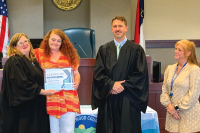Feeling alive: Waynesville chiropractor reflects on decade as professional mountain climber
 The little storefront that serves as home base for Todd McDougall’s chiropractic office looks just about how you’d expect such an office to look — reception desk at the front, neutral walls and an exam room with padded table inside. But the smattering of framed mountain snowscapes on the wall of that exam room give a clue as to what “normal” looked like for McDougall before setting up shop in Waynesville.
The little storefront that serves as home base for Todd McDougall’s chiropractic office looks just about how you’d expect such an office to look — reception desk at the front, neutral walls and an exam room with padded table inside. But the smattering of framed mountain snowscapes on the wall of that exam room give a clue as to what “normal” looked like for McDougall before setting up shop in Waynesville.
“I would look back after those years, and I had climbed over 60 mountains over 20,000 feet,” McDougall said. “That was six times a year I was at 20,000 feet, and that’s kind of a lot.”
McDougall got bit early by the mountain climbing bug, as a high-schooler in Massachusetts when he became the victim of a weekend rock climbing trip that set him moving along the road less traveled.
“I was hooked instantly,” he recalled. “I was just like a monkey, naturally.”
He liked the full-body movement, the sensory stimulation from the textures of different rocks and geologies. So, after college and a two-year Peace Corps tour in West Africa, McDougall, now 53, found himself working as a professional mountain climbing guide with American Alpine Institute. It was something he’d do for about 10 years.
It was a year-round gig, mostly, with winters spent ice-climbing in Colorado, springs in California or Nevada and summers in Bolivia, trips to Nepal or Ecuador or Mexico sometimes thrown into the mix. He’d usually wind up with a few months off in the fall — and that leisure time would also go to mountain climbing. That’s when he’d embark on personal expeditions to the peaks of Nepal, Pakistan or India.
Related Items
It was full-force living, all the time.
“At the beginning it was more just adventure and fun, so when dangerous things happened, it was just fun,” McDougall said. “But as I did it longer and longer, it became more serious. I think I became more conservative as I went.”
When you’re exploring miles above sea level on an isolated landscape, things can happen. And they did.
“Luckily nobody died on any of our trips,” McDougall said. “But we did have lots of adventures.”
Adventures aplenty
Like, the time the group he was guiding crossed a high plateau in Bolivia. Roped together, the five of them were walking across an angled snowfield next to a 900-foot drop-off when an avalanche began, right where they were standing.
“We all got dragged to the cliff, and the last guy ended up being over the cliff when we finally got the rope to come to a stop,” McDougall said.
When the avalanche started, McDougall flew into action, digging his axe into the ice and straining to create friction with his feet and belly, but the slide continued. The rope became taut, dragging him 10 feet closer to the edge. For a moment, he considered cutting it, so at least one person would survive. He squashed the impulse.
“As a guide, you can’t be the only one who survives,” he said.
Luckily, the avalanche ran out of steam, the snow chunks falling over the cliff and the five climbers grinding to a halt.
“You could hear it hit the ground 900 feet below,” McDougall recalled. After that incident, the group voted unanimously to descend, rather than keep striving for the summit.
When things fall from one surface, they have to land on another. One of McDougall’s close calls came when grapefruit-sized rocks began raining from somewhere 1,200 feet above his head.
“I think it was goats that were doing it, because there was nobody up there,” McDougall said. “If it hits you, you’re dead.”
Then there was the “normal” kind of hard. People would fall into crevasses all the time. Just walking can be a monumental task when you’re negotiating a field full of obstacles. And melting water when you’re so high up and at such low temperatures is difficult, requiring the stoves to stay running eight hours per day to melt enough snow for everybody.
“Most accidents are on the way down from the summit, when people are tired and they think they’ve arrived,” McDougall said.
Mountains can be wild. But they’re also rewarding. One of McDougall’s favorite memories is of summiting Nepal’s 22,350-foot Ama Dablam, alone.
Being on top of that isolated mountain, just him and the snow and the rock and the sky, is a memory he goes back to.
“Usually you just felt alive, like oh my God this is awesome,” he said. “Risking it makes you feel more alive in a way.”
Not in a reckless kind of way, he emphasized. More in a way that has you testing your limits but still living within what you know you can do. Every day pushing the envelope a little more, building your skills a little taller, and making it to take in the view from the top.
Letting it go
It’s been more than a decade since McDougall’s climbed anything over 20,000 feet. He hit a point, out there in the wild, when the desire to climb left him. He began to think it might be kind of nice to have a home rather than traveling all year, to have neighbors and a hometown community.
He can remember the trip when it happened.
He and a buddy had taken a trip to India, setting out to scale a previously unclimbed 8,000 face in the Himalayan Mountains. Everything went wrong.
“We ran out of food for two days and we were freezing and it snowed 4 inches every single night and we were getting hit with spindrift avalanches all day, every day,” he said. “It was serious.”
They made it to the top. But on the way down, they came to an edge amid the glaciers with nowhere to go. They were too tired to conceive of walking all the way back. So, they took out a rope, laid it out with the center on the ground in front of them and the ends dangling on either side of the edge, and they rappelled down on opposite sides, hoping that the rope was long enough to reach the bottom.
“We didn’t care at that point,” McDougall said. “We were so tired.”
Luckily, the rope took his buddy all the way to the ground and him just 4 feet away from it. They hit the ground on their respective sides of the glacier and began hiking out, rejoining paths five or ten minutes later. It was a desperate situation, and it could easily have turned out differently.
When the dust settled, McDougall was left with the realization that he was ready to leave the serious mountain climbing behind.
So, chiropractic.
From climbing to chiropractic
From the outside, it looks like a long leap. But for McDougall, it made sense.
Just as mountain climbing is based on routes and maps and recall of the boulders and streams and trees that mark the way, chiropractic is a discipline of landscapes, at least in McDougall’s mind. When he sees a patient’s body, he sees a landscape of bones and muscles and traces of the places he’s worked before.
“To me, that’s mountain climbing,” McDougall said. “It’s the same set of skills in a sense, which is maybe a little abstract for some people, but it seems right on for me.”
So too, did the Appalachians, where McDougall and his wife Hayley — who he met in chiropractic school — opted to move after finishing their education. They’re tame mountains compared to the rugged Andes and Himalayas. But they felt right.
“They just have a story to tell that reminds me of the other mountains,” McDougall said. “They’re the oldest mountains in the world, so at one point they were really jagged.”
Anyway, he’s done with the crazy-intense, death-defying expeditions.
But he has a 15-month-old daughter, and he can see helmets, harnesses and rope in her future.
“I’ll probably teach her to climb,” he said.









